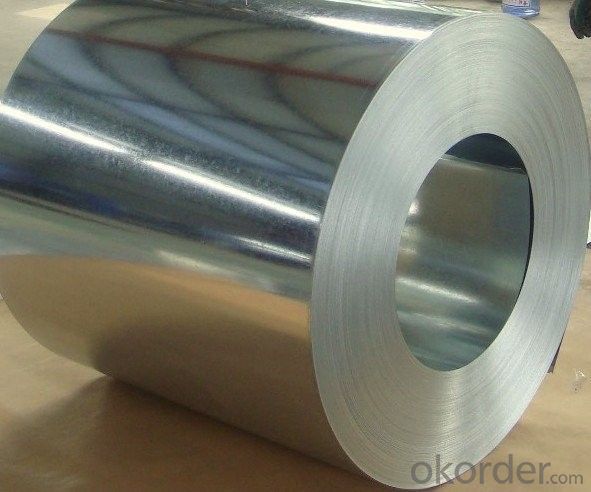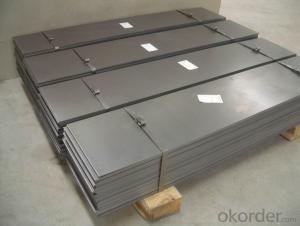Hot Dipped Galvanized Steel Coil/Hot Dipped Galvanized Steel Strips Coil/Zinc Coated Steel Coil
- Loading Port:
- Tianjin
- Payment Terms:
- TT OR LC
- Min Order Qty:
- 500 m.t.
- Supply Capability:
- 100000 m.t./month
OKorder Service Pledge
OKorder Financial Service
You Might Also Like
Hot Dipped Galvanized Steel Coil/Hot Dipped Galvanized Steel Strips Coil/Zinc Coated Steel Coil Specifications:
Steel strips coils galvanized
Material: Q195, Q215, Q235, Q345B, SGCC, DX51D+Z
Thickness:0.75-4.5mm
Width:32-750mm
Zinc coating: 60-550g/m2
Hot Dipped Galvanized Steel Coil/Hot Dipped Galvanized Steel Strips Coil/Zinc Coated Steel Coil Description:
Galvanized steel coil are widely used in the construction industry, as raw material for the production of corrugated panels, fencing products, drywall panel profiles, ventilation systems etc. Recommended for both outside and inside usage, galvanized steel has a high resistance to corrosion in different environments, due to a protective layer of zinc of 100 – 180 grams per square metre.
Main Features of Hot Dipped Galvanized Steel Coil/Hot Dipped Galvanized Steel Strips Coil/Zinc Coated Steel Coil:
Hot-dip galvanized steel coils are produced by immersing steel in a zinc bath. An appropriate galvanizing process requires a pretreatment process during which the steel passes through different baths which prepare the surface for zinc coating. In this stage, chemicals are used to clean the surface of the steel. After the chemical treatment, the steel coils pass through a bath of melted zinc at temperatures around 460 ° C. The resulting uniform coating is finished through a process of skin-passing to provide smooth and shiny appearance of the finished product. To store for a longer period, the hot-dip galvanized coils can be delivered with a final oil coating, according to the customer’s demand.
Hot Dipped Galvanized Steel Coil/Hot Dipped Galvanized Steel Strips Coil/Zinc Coated Steel Coil Images:

FAQ:
What certificates do you have for your products?
ISO
- Q:Are steel strips suitable for making household appliances?
- Yes, steel strips are suitable for making household appliances. Steel is a durable and strong material that can withstand the rigors of daily use in appliances. It offers good resistance to heat, corrosion, and wear, making it ideal for various applications in household appliances like refrigerators, ovens, washing machines, and more. Additionally, steel strips can be easily molded and shaped into different forms, allowing for flexibility in design and functionality.
- Q:How are steel strips processed for surface embossing?
- In order to achieve the desired texture and pattern, steel strips go through a series of steps for surface embossing. Initially, the strips are thoroughly cleaned and inspected to ensure a smooth and contaminant-free surface that won't interfere with the embossing process. Then, the strips are fed into a rolling mill machine, where pressure is applied to the steel surface. This rolling mill is equipped with embossing rolls that contain the desired pattern engraved on them. As the steel passes through these rolls, the pattern is transferred onto the strip's surface. To enhance the visual appeal of the embossed pattern and improve its durability, the steel strips can undergo additional processes like tempering or annealing. These heat treatments not only increase the flexibility and durability of the steel, but also enhance the embossed pattern. Once the embossing process is complete, the steel strips may undergo further finishing processes to enhance their appearance and protect them from corrosion. These processes may include cleaning, coating, or polishing. In conclusion, the surface embossing of steel strips involves a sequence of steps. These steps include cleaning, inspection, rolling through embossing rolls, optional heat treatments, and finishing processes. By following these steps, the steel strips are transformed into durable and visually appealing products with embossed patterns.
- Q:How are steel strips used in the manufacturing of industrial machinery?
- Steel strips are used in the manufacturing of industrial machinery as they provide high strength and durability, allowing for the construction of robust machine components such as gears, frames, and structural supports. The strips are often processed and shaped into desired forms through techniques like rolling, cutting, and bending, enabling their integration into various machinery parts. Additionally, steel strips can be surface-treated or coated to enhance their resistance to corrosion and wear, further improving the longevity and performance of the industrial machinery.
- Q:How do steel strips respond to different surface coating processes?
- Steel strips respond differently to different surface coating processes based on the type of coating applied. For instance, galvanization, which involves coating steel with a layer of zinc, provides excellent corrosion resistance. On the other hand, electroplating with chrome enhances the steel's aesthetic appeal while providing moderate protection against corrosion. Additionally, powder coating offers a durable and decorative finish, while painting enables customization and can provide varying degrees of protection depending on the type of paint used. Ultimately, the response of steel strips to surface coating processes is influenced by the specific coating method and its intended purpose.
- Q:What are the common joining methods for steel strips?
- The common joining methods for steel strips include welding, soldering, riveting, and using mechanical fasteners such as screws or bolts.
- Q:What is the typical thickness tolerance for steel strips?
- The typical thickness tolerance for steel strips can vary depending on the specific application and industry standards. However, a common range for thickness tolerance in steel strips is typically around ±0.001 to ±0.005 inches.
- Q:How are steel strips processed for surface leveling?
- Steel strips can be processed for surface leveling through a variety of methods. One common technique is called roller leveling, which involves passing the steel strip through a series of rollers under high pressure. These rollers apply force to the strip, gradually bending it in the opposite direction of the surface irregularities, effectively leveling the surface. Roller leveling can be performed as a standalone process or incorporated into a continuous processing line, such as a rolling mill. Another method used for surface leveling is called tension leveling. In tension leveling, the steel strip is subjected to tension forces while being passed through a series of bridle rolls. These rolls are positioned at different angles to stretch and elongate the strip, reducing surface irregularities and improving flatness. Tension leveling is particularly effective in eliminating crossbow and center buckle defects in the steel strip. Additionally, some steel strips may undergo a process called temper rolling. In this method, the strip is heated and then rapidly cooled, which alters the metallurgical structure of the steel and improves its flatness. Temper rolling can also enhance the mechanical properties of the strip, such as its hardness and strength. It is worth noting that the specific process used for surface leveling may vary depending on the requirements of the steel strip and the desired end product. Different combinations of roller leveling, tension leveling, and temper rolling can be employed to achieve the desired surface quality, flatness, and dimensional accuracy of the steel strip.
- Q:What are the different packaging options for steel strips?
- Some different packaging options for steel strips include coil form packaging, strapped bundles, wooden crates, and metal drums. These options help protect the steel strips during transportation and storage, ensuring their quality and preventing any damage or deformation.
- Q:How are steel strips used in the manufacturing of lighting fixtures?
- Steel strips are used in the manufacturing of lighting fixtures to provide structural support, enhance durability, and ensure proper alignment of components. They are often used as a base or frame material for holding the different parts of a lighting fixture together, ensuring stability and preventing deformation. Additionally, steel strips can be shaped and formed into various components such as brackets, hangers, or clips, allowing for efficient assembly and installation of lighting fixtures.
- Q:How are steel strips tested for tensile strength?
- Tensile testing is the method used to test the tensile strength of steel strips. This method involves applying a force to the strip until it breaks, while measuring the force required for the break. Typically, this testing is done using a specialized machine called a tensile testing machine. To conduct the test, a sample of the steel strip is prepared in a specific shape and size, usually in the form of a dog bone-shaped specimen. The specimen is then securely clamped into the grips of the tensile testing machine. One grip is attached to the upper part of the machine, while the other grip is attached to the lower part. Once the specimen is in place, the machine gradually applies an increasing force in the opposite direction of the clamps. This force causes the steel strip to stretch and elongate until it eventually fractures. Throughout this process, the machine records the applied force and the corresponding elongation of the strip. The recorded data is then plotted on a stress-strain curve, which illustrates the relationship between the applied force (stress) and the resulting deformation (strain) of the steel strip. By identifying the maximum force the strip can withstand before breaking, the tensile strength of the strip can be determined. Tensile testing provides valuable information about the mechanical properties of the steel strip, including its ultimate tensile strength, yield strength, and elongation. These properties are crucial in determining the suitability and quality of the steel strip for specific applications in industries such as construction and manufacturing.
1. Manufacturer Overview |
|
|---|---|
| Location | |
| Year Established | |
| Annual Output Value | |
| Main Markets | |
| Company Certifications | |
2. Manufacturer Certificates |
|
|---|---|
| a) Certification Name | |
| Range | |
| Reference | |
| Validity Period | |
3. Manufacturer Capability |
|
|---|---|
| a)Trade Capacity | |
| Nearest Port | |
| Export Percentage | |
| No.of Employees in Trade Department | |
| Language Spoken: | |
| b)Factory Information | |
| Factory Size: | |
| No. of Production Lines | |
| Contract Manufacturing | |
| Product Price Range | |
Send your message to us
Hot Dipped Galvanized Steel Coil/Hot Dipped Galvanized Steel Strips Coil/Zinc Coated Steel Coil
- Loading Port:
- Tianjin
- Payment Terms:
- TT OR LC
- Min Order Qty:
- 500 m.t.
- Supply Capability:
- 100000 m.t./month
OKorder Service Pledge
OKorder Financial Service
Similar products
New products
Hot products
Related keywords



























